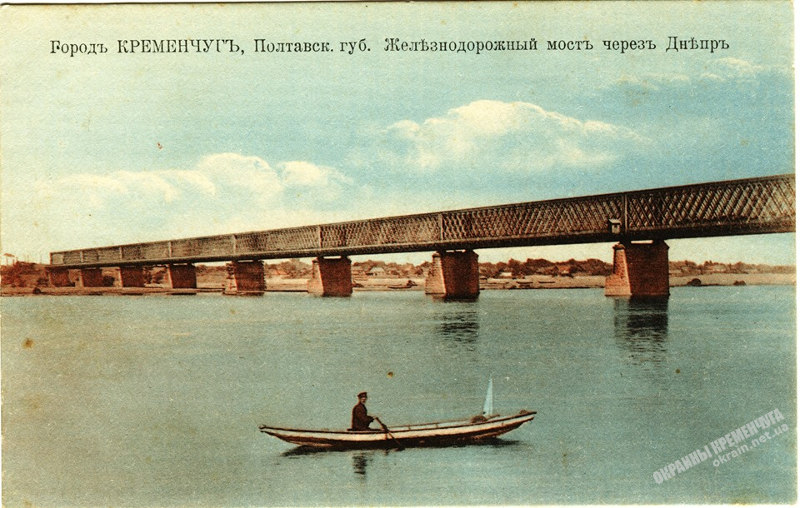The emergence of a bridge across the river. Dnieper our city is obliged to the Kharkov-Nikolaev railway. In 1870, the railway approached the city from two sides: Kharkov-Kremenchug and Elizavetgrad-Kryukov. Engineer-colonel A. Struve was entrusted to combine these sectors into one line. A. Struve already had to design and build bridges across the river. Oka in Kolomna, Serpukhov and across the Dnieper in Kiev. But the bridge over the river. The Dnieper in Kremenchug is the largest of all those built by A. Struve earlier.
The metal bridge in Kremenchuk consisted of 12 iron trusses resting on two stone abutments on both banks of the river and river oxen based on caissons. The length of the bridge is 962 m. The bases of the bulls and coastal abutments are lowered to the rocky ground. The rails were laid on the cross beams of the trusses, and for the passage of horse-drawn vehicles, a flooring was made of boards. Struve built the bridge thoroughly and it is not surprising that the new bridge rebuilt after the war rests on the same bulls.
Its construction was completed a year ahead of schedule, which saved the treasury over 1 million rubles. The grand opening and consecration of the bridge took place on March 25, 1872. Following the bridge in Kremenchug, A. Struve built the famous Liteiny Bridge in St. Petersburg.
Crossing the river. The Dnieper in its middle reaches subsequently made Kremenchug a bridgehead city of strategic importance, because the nearest bridge crossings were only in Cherkassy and Dnepropetrovsk. In the civil, and then in the Patriotic War, arrows of military strikes were directed at him. Needless to say, the capture of the bridge was the main task of all military campaigns carried out on the banks of the Dnieper. During the last war, the bridge, which is of great strategic importance, was blown up and rebuilt in 1949.
Its design has changed – it has become two-tier, the length of the spans has increased and, accordingly, the number of river bulls has decreased, the carrying capacity of the bridge has increased, now it is over 100 tons.
The military exploits of the defenders of the bridge are marked by monuments and obelisks. Unfortunately, a memorial plaque destroyed by the Nazis, installed on one of the houses at the beginning of st. Shevchenko (the exit from the bridge overlooked this street at that time) was never restored. And she appeared in memory of six Komsomol girls who were hacked to death on the bridge by White Cossacks for their underground Bolshevik activities. The bodies of the girls were thrown by the Cossacks from the bridge into the Dnieper. On the memorial plaque, opened on November 13, 1936, (the author is the architect L. Shlapakovsky), their photographs were installed in a granite frame and their names were listed:
V. Gottlieb,
E. Gordon,
E. Brandman,
P. Kaplun,
J. Lozner,
S. Galper.
The text above the photographs read: “On the whole bridge, the villainous hands of the violent bandits have lost the death of the good-looking donka Lenin’s Komsomol.”
In Kryukov at the bridge over the river. The Dnieper is a monument to the revolutionary sailors of the Dnieper flotilla. The backbone of the flotilla was made up of Baltic sailors who arrived in Kremenchug from Kronstadt. The flotilla was commanded by sailor A.V. Polupanov. Great help in organizing the flotilla was provided by a resident of our city V.A. Soft, elected in 1919 as a delegate to the VII Congress of Soviets. The headquarters of the flotilla was located on the armored train number 8. The flotilla took an active part in the battles against the Denikinites and numerous bands. In September 1920, in a heavy battle, the sailors did not allow a large detachment of bandits to cross to the left bank of the Dnieper and unite with the Makhnovists. In memory of the heroic sailors in 1940, this monument was erected. The authors of the monument were amateur sculptors Molchanov and G. Dziuba. In 1988, the monument was reconstructed and it took on its present appearance. The authors of the project are sculptors P. Chechel and N. Posikira. Here, on the other side of the road, there is also a modest obelisk on the grave of the bridge builders who died during the explosion of ice fields during the ice drift on the river. Dnepr March 30, 1946 At the cost of their lives, four sapper warriors saved the railway bridge under construction across the river from destruction from destruction. Dnieper, thus ensuring its early restoration. The restored bridge made it possible to open uninterrupted train traffic on the Southern Railway towards Znamenka, Odessa, and from the south to Kharkov and Romodan.
The author of the article: Ivushkin V.E.

